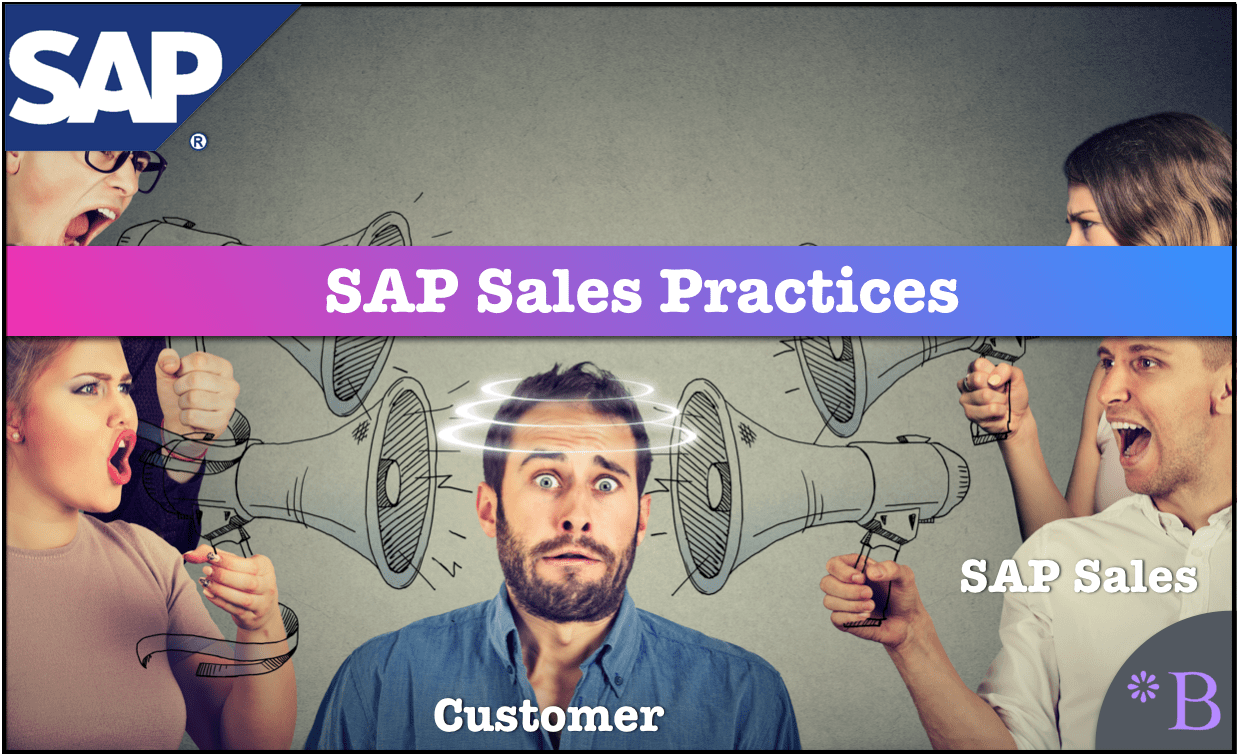The Sales Reason for the High Failure Rate of SAP Projects
Executive Summary
- SAP projects have large numbers of failed implementations.
- This coverage of SAP’s sales process by E3Zine helps explain why.

Video Introduction: The Sales Reason for the High Failure Rate of SAP Projects
Text Introduction (Skip if You Watched the Video)
In the article How SAP is Now Strip Mining its Customers, we covered how SAP has many failures. One reason for this that the immaturity of so many of SAP’s products and that so many of SAP’s implementations either fail or fail to meet expectations. A second reason or problem is that the SAP sales process is so misleading and creates such inaccurate expectations that the reality of SAP’s products cannot meet. And the article The End of SAP Relationship Management by N. N. Nomen Nescio (that is an anonymous contributor) in the E3Zine publication explains why and describes the chaos that SAP sales design creates at SAP customers.
The E3Zine Article Quotations
The Motivations of Sales
SAP CEO Bill McDermott transformed the company into a sales-driven organization. There’s two ways in which SAP salespeople try to reach McDermott’s high revenue goals.
One, through dubious interpretations of licensing fees and contracts (Indirect Access); and two, through selling unnecessary and often unfinished products that nobody needs to fulfill the sales quota.
Licensing fees seem to be the primary revenue generator at the moment. Many salespeople probably only reached their sales quota through Indirect Access. The possibilities to interpret it are endless. Many customers save themselves from Indirect Access by signing a cloud contract, which seems to pacify SAP salespeople. – E3Zine
This is a problem in that salespeople cannot meet quotas without indirect access. There are several reasons for this.
- SAP has made several acquisitions, but there is a tiny cross over between the internally developed SAP product customers and the additions. Essentially, the acquisitions make no business or sales sense and seem primarily driven by the need to deliver a story to Wall Street.
- SAP has not successfully migrated many customers to S/4HANA, which we covered in the article The S/4HANA Implementation Buyer Intelligence Highlights.
- Customers that have been pushed to HANA have had very mixed results from what SAP told customers was a groundbreaking database.
- Most of the internally developed non-ERP products like PO/PI, PLM, BW, APO, CRM, and many others have played themselves out. They are now known to be of low quality, and they are challenging to implement, difficult to use and damage the companies that purchase them.
SAP’s Enormous and Complex Product List
SAP has thousands of products, changes its metrics frequently, and makes and retracts announcement even more often. This explosive formula only leads to chaos for customers. However, it also opens up the perfect opportunity for SAP salespeople to get the customer to buy a new license.
This means that while companies have to deal with SAP’s arbitrary definition of Indirect Access, new SAP salespeople from Ariba, Hybris, Concur and SuccessFactors are eagerly knocking at their door to sell them new products and even more licenses – resulting in chaos for the customers. – E3Zine
When we counted the SAP product list, we came up with over 300; as we covered in the article, How Many Products Does SAP Have?
However, if you include each of the product’s variants, you can develop more, and we assume this is how E3Zine performed their count. And E3Zine is correct, and this leads to chaos. The complexity of the SAP product database is far beyondSAP sales reps’ capacities to keep up with it. This is why we have proposed that SAP has grown so large that it has essentially become unmanageable. It also means that SAP is increasingly a liability to its own customers because its sales reps, as well as consultants, often do not know the actual reality of the products.
Losing Touch With Reality
The new SAP salespeople from acquired companies don’t know anything about ECC 6.0, ERP’s history or traditional licensing contracts. As mentioned before, it’s not about relationship management anymore – it’s about reaching a sales quota. – E3Zine
This is precisely correct. The entire sales process has moved increasingly to transactional behavior, which is a fit with McDermott’s short term orientation.
Conclusion
This article from E3Zine receives a 10 out of 10 for accuracy in their article.
The things that E3Zine points out are precisely what we find in our research and contacts with ongoing SAP projects and sales initiatives. E3Zine should also be commended for being willing to tell the truth on this topic.
Secondly, the SAP sales processes damaged natures are why SAP projects have such a high failure rate. SAP products are being sold with little concern for how the application will be implemented or whether the application fits with the actual requirements at the account. Under this extreme quota, salespeople cannot afford to consider and expect to keep their job.
References
*https://e3zine.com/2019/07/25/sap-relationship-management/